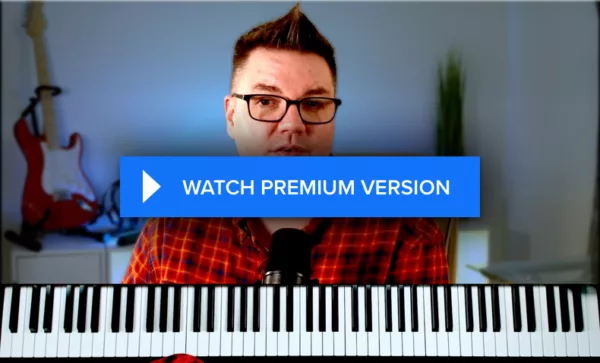Red Garland’s Signature Comping Rhythm #
Red Garland, band leader and pianist from the Miles Davis Quintet, swings harder than just about other jazz pianist out there. His swing feel is rhythmically precise and consistent, and so much of his style emanates from the comping patterns he plays with his left hand.
Before we dig into the intricacies of his signature style, let's listen carefully to one of his recordings. I would suggest to start with his classic recording of C-Jam blues. While there's so much to learn from this track, pay close attention to the rhythm in his left hand.

Step-by-Step Video Training
As a premium member of Jazz-Library you will have access to our Jazz Fundamentals video course which has 70+ video lessons teaching you these comping rhythms, chord voicings, soloing strategies and more.
Here are some things I notice when listening carefully:
- Comping Rhythm: By default, he plays off the beat on the swung 8th note behind beats 2 and 4. But it wouldn't be syncopation if it was always off the beat. Listen how he occasionally reminds you where the downbeat is by playing square on the beat.
- Articulation: It's short, perfectly in time, yet gentle. He's not aggressively stabbing at notes, rather, it's precise and subtle.
- Anticipating the harmony: When playing on the up-beat, his left hand plays the upcoming chord change, not the current chord.
Red Garland's Comping Rhythm (left hand) #
Where many of his contemporary piano players would think of their left hand as a bass drum and snare, I think of Red Garland's left hand more like a ride cymbal.
Here's a stereotypical ride cymbal pattern:

Notice in this drum pattern that the bass drum and snare drum play on the beat, but only the ride cymbal plays off the beat. Because of that, it's the ride cymbal that imparts the swing feel.
Stride players heavily emphasize the downbeats with their left hand using an oom-pah style bass, relying on their right hand rhythm to impart the swing feel. But not so in Red Garland's playing. Instead, Red chooses to emphasize those ride cymbal off-beats with his left hand:

Emphasizing the off-beat #
When I was back in conservatory first learning how to play jazz, I learned that when the up-beats should be played more strongly than the downbeats. The shorter notes, by their nature, are harder to hear and need to be played more strongly to sound equal. That is as true when playing Bach as it is Oscar.
But in Red's style, the off-beats shouldn't sound equal in volume. The off-beats should be quite strongly emphasized. The music swings harder that way.
Try playing each of these examples with a swung 8th note feel. Both examples have the same notes and rhythm, but they apply the accents in different ways.
This first example emphasizes the notes on the downbeats:

Now try the same line with the accents on the up-beats:

It’s remarkable how much difference the emphasis and articulation can make, isn’t it?
Now try this same example with Red's signature left hand comping pattern. It swings even harder!

This illustrates the premise behind Red’s comping pattern. He’s using his left hand to emphasize the upbeat notes, which makes you really feel the swing.
Articulation #
Many times when I hear people play in Red Garland's style, they "stab" at the keys rather aggressively. While they get the timing right, its just too violent. It should be a subtle brush of a hand on the small of the back, not a jab in the eye.
It's a little difficult to play short, soft and rhythmic, especially in this syncopated rhythm. I would encourage you to focus on getting the articulation right, even if it means playing the notes a bit longer.
For this reason, I tend to notate this rhythm as a tie over the beat as in my previous examples. Technically that's too long, but better too long than too aggressive or too lazy.
Anticipated Chords #
I previously described Red's rhythm as being on the off-beat of 2 & 4, but I think Red actually considers himself to be an 8th note ahead of the next beat.
Let's look again at the excerpt from earlier. Previously we were focused on the rhythmic placement of the notes, but now look at the chord itself:

Measure 1 is an F7 chord and measure 2 is Bb7. Yet, when Red plays on beat 4 he plays the Bb7 early. It's as if his left hand is ever so slightly in front of his right hand. Look again at beat 4 of the 2nd measure, and you'll see him anticipating an F7 in the 3rd measure as well.
This can sound a bit like things are always pushing forward rather than sitting "in the pocket."
Conclusion #
I hope this article inspires you to listen to Red Garland's left hand more intensely. There's so much to learn that words just can't adequately describe.
PS. Can you believe Red Garland started his career as a welterweight boxer!? I guard my hands like my life depends on them, yet he was going toe to toe with Sugar Ray Robinson. What a guy.
